Green Innovation at the Crossroads
Why India and Korea Are Perfect Partners for Sustainable Development
The world stands at a critical juncture. Climate change threatens ecosystems, economies, and communities globally, while the demand for energy continues to surge. By 2030, Asia alone will account for nearly 50% of global energy consumption. Within this landscape, two nations are emerging as unlikely but perfect partners in the green transition: India and South Korea.
India, the world's most populous nation with ambitious renewable energy targets, brings unprecedented scale, a young workforce, and rapidly expanding manufacturing capabilities. South Korea, a global technology powerhouse, offers cutting-edge innovation in batteries, hydrogen fuel cells, and smart infrastructure. Together, these nations represent a $100+ billion opportunity to reshape Asia's sustainable future.
At Donghaeng-Manthan, we believe this partnership isn't just beneficial—it's essential for both nations to achieve their climate goals and lead the global green economy.
Introduction


The Challenge: Two Nations, One Urgent Mission
India's Sustainability Imperative
India faces a unique challenge: achieving rapid economic development while meeting aggressive climate commitments. With a GDP growth target of 7-8% annually and a pledge to reach net-zero emissions by 2070, India must leapfrog traditional development pathways.
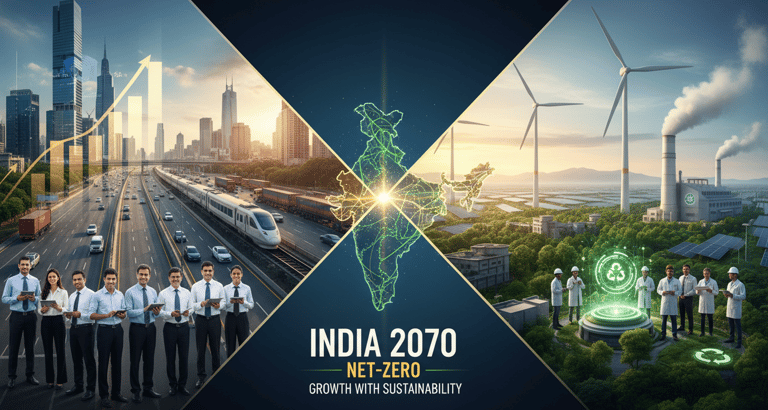

India needs to install 500 GW of renewable energy capacity by 2030 (currently at ~180 GW)
Urban population expected to grow by 416 million by 2050Energy demand projected to double by 2040
Current renewable energy investments: $14-15 billion annually—needs to triple
The Numbers Tell the Story:
India's challenges are immense, but so is its potential. The country has become the world's fourth-largest renewable energy producer, with some of the lowest solar tariffs globally. However, technology gaps remain in critical areas: advanced battery storage, green hydrogen production, and smart grid management.
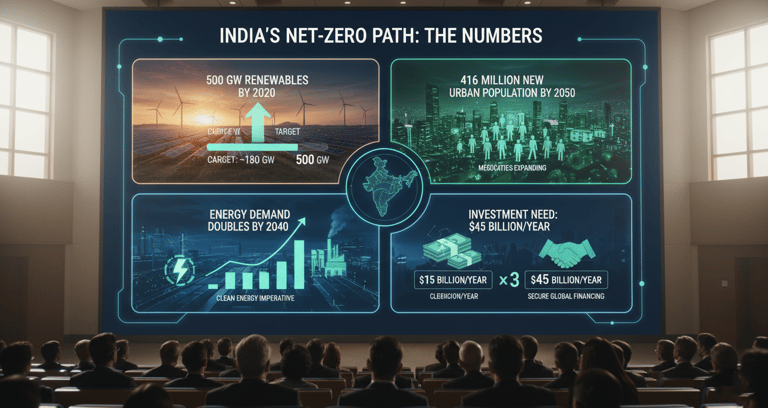

South Korea's Green Pivot
South Korea, despite being the world's 7th largest carbon emitter, has committed to carbon neutrality by 2050 and pledged to cut emissions by 40% by 2030. The Korean government has invested heavily in its "Green New Deal," allocating $95 billion toward green infrastructure and technology.
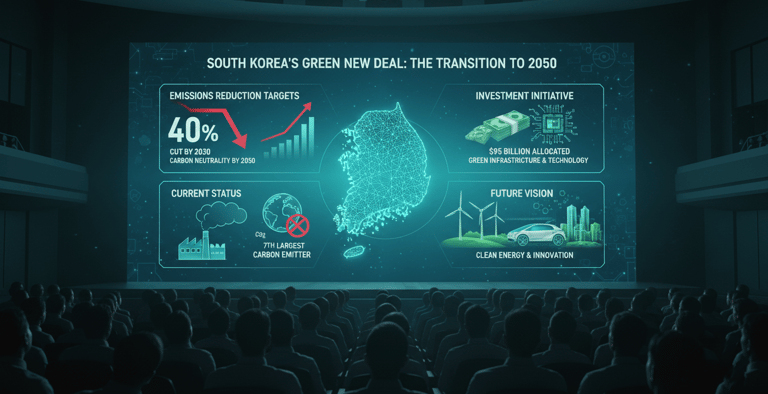

Korea's Strengths:
Global leader in battery technology (LG Energy Solution, Samsung SDI, SK Innovation)
Advanced hydrogen fuel cell capabilities
Smart city infrastructure and IoT integration
Precision manufacturing and quality control systems
Yet Korea faces its own limitations: limited land for large-scale renewable installations, high energy import dependency (between 90% to 97% of energy imported), and the need for export markets to scale its green technologies commercially.
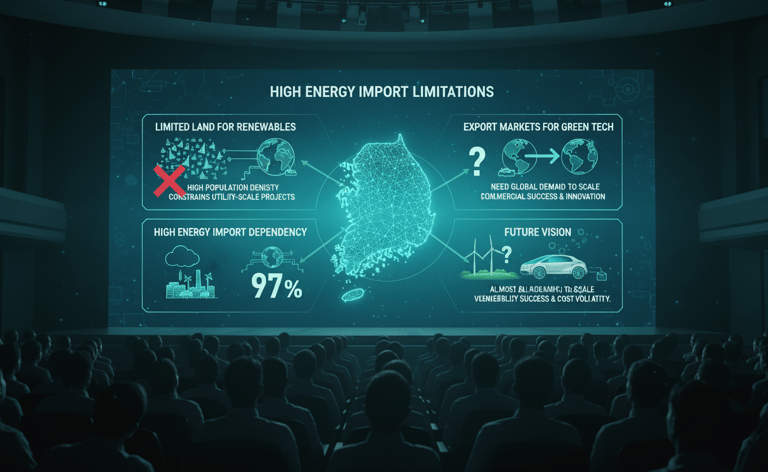

The Opportunity:
Complementary Strengths, Exponential Impact
What India Brings to the Table
What South Korea Brings to the Table
Unmatched Scale and Market Potential
1.4 billion consumers creating massive demand for green solutions
Vast land availability for renewable energy installations (solar, wind)
World's third-largest energy consumer and fastest-growing major economy
Low-cost manufacturing capabilities and competitive labor markets
2. Innovation at Scale
Thriving startup ecosystem with 7,000+ clean tech startups
World-class engineering talent pool (2.6 million engineering graduates annually)
Proven ability to adapt and indigenize technologies
Government initiatives like Production-Linked Incentives (PLI) supporting green manufacturing
3. Renewable Energy Leadership
World's fourth-largest installed renewable capacity
Largest solar power expansion program globally
Ambitious green hydrogen mission targeting 5 MMT production by 2030
Competitive renewable energy costs (solar at ₹2-2.50/kWh)
1. Technology Excellence
Global leader in lithium-ion battery technology (40% global market share)
Advanced fuel cell and hydrogen storage technology
Smart grid and energy management systems
High-efficiency solar panel manufacturing
2. R&D and Innovation Culture
One of the world's highest R&D investments (4.8% of GDP)
Strong government-industry-academia collaboration
Rapid prototype-to-market commercialization
Quality control and process optimization expertise
3. Financial and Strategic Investment
Strong sovereign wealth and corporate investment capacity
Experience in international technology partnerships
Strategic focus on green economy as economic driver
Established global supply chain networks


The Perfect Synergy
Battery Technology: Korean battery expertise + Indian manufacturing scale = Cost-effective EV revolution
Green Hydrogen: Indian renewable energy production + Korean fuel cell technology = Export-quality hydrogen economy
Smart Cities: Korean smart infrastructure + Indian urbanization scale = Sustainable megacities
Solar Manufacturing: Korean high-efficiency panels + Indian production capacity = Global solar supply chain leadership
Circular Economy: Korean recycling technology + Indian material recovery potential = Sustainable resource management


When India's scale meets Korea's precision, transformative possibilities emerge:
How Collaboration Works: From Vision to Reality
Existing Frameworks and Momentum
India and Korea have already laid the groundwork for deeper collaboration:
Government-Level Initiatives:
Comprehensive Economic Partnership Agreement (CEPA) 2010
Joint Statement on Special Strategic Partnership (2015)
Future Strategy Group for bilateral cooperation
Regular CEO Forums and business exchanges
Active Collaborations:
Korean investment in Indian solar projects exceeds $2 billion
Samsung and LG establishing battery and electronics manufacturing in India
Hyundai's significant EV manufacturing presence in India
Joint research projects through institutional partnerships
Technology Transfer and Knowledge Exchange


Effective green technology collaboration requires:
1. Joint R&D Centers
Co-located research facilities in both nations
Shared intellectual property frameworks
Student and researcher exchange programs
Collaborative testing and certification facilities
2. Manufacturing Partnerships
Joint ventures for battery manufacturing
Technology licensing with localization provisions
Supply chain integration between Korean suppliers and Indian manufacturers
Quality standard harmonization
3. Financing Mechanisms
Green bonds and climate financing vehicles
Public-private partnership models
Export credit support for bilateral projects
Venture capital funds focused on India-Korea green startups
Policy Enablers: What's Needed


To fully realize this potential, both governments must:
For India:
Streamline technology import and IP protection
Offer competitive incentives for Korean green tech investment
Fast-track approvals for joint venture projects
Develop skilled workforce for advanced manufacturing
For Korea:
Provide export financing for technology transfers
Support Korean companies' long-term India strategies
Share best practices in policy implementation
Facilitate knowledge transfer programs
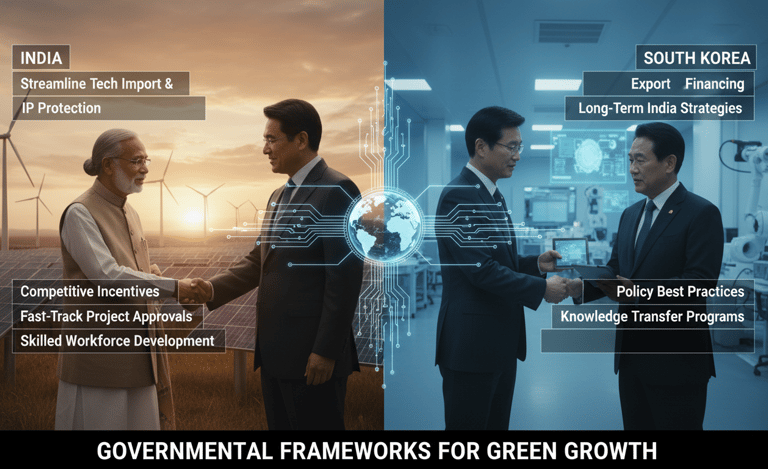

Case Study: The Battery Story


The India-Korea collaboration in battery technology illustrates this partnership's potential.
The Challenge: India's EV market is projected to grow at 49% CAGR, reaching 10 million units by 2030. However, India imports nearly 70% of lithium-ion cells, creating supply chain vulnerabilities and cost pressures.
The Korean Solution: LG Energy Solution announced a $1.4 billion investment to manufacture EV batteries in India. Samsung SDI and SK Innovation are exploring similar partnerships.
The Impact:
Projected to reduce battery costs by 30-40% through local manufacturing
Creating 10,000+ direct jobs and 50,000+ indirect jobs
Enabling Indian EV manufacturers to compete globally
Building supply chain resilience in Asia
Technology transfer creating local R&D capabilities
The Learning: When Korean technology precision meets Indian manufacturing scale and market demand, both nations win. Korean companies access a massive growth market, while India gains advanced technology and manufacturing capabilities.
The Path Forward: Donghaeng-Manthan's Role
At Donghaeng-Manthan, we see our role as the catalyst and facilitator for this transformative partnership.
Our Focus Areas in Green Innovation:
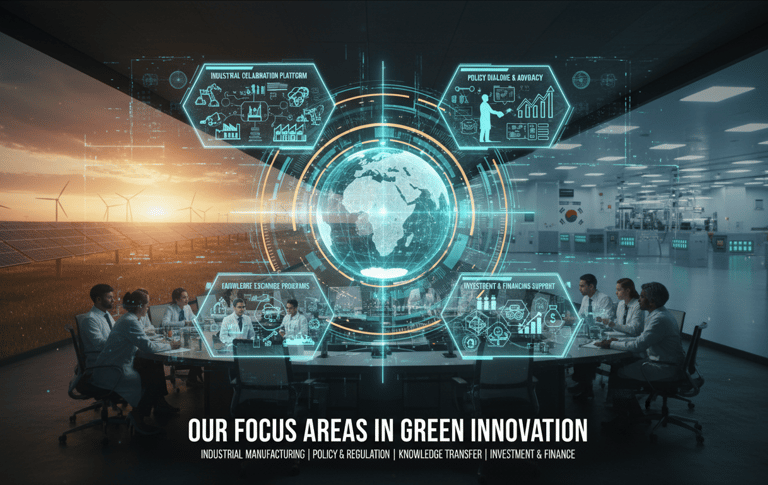

1. Industrial Collaboration Platform
Connecting Korean green tech companies with Indian manufacturing partners
Facilitating joint ventures in renewable energy, batteries, and hydrogen
Creating matchmaking events and business forums
Providing market intelligence and entry strategy support
2. Policy Dialogue and Advocacy
Organizing forums for policymakers from both nations
Publishing research on regulatory harmonization
Advocating for streamlined collaboration frameworks
Sharing best practices and policy innovations
3. Knowledge Exchange Programs
Technical training programs for Indian engineers in Korean technologies
Student exchange programs in clean energy research
Executive education on sustainable business models
Virtual collaboration platforms for ongoing learning
4. Investment and Financing Support
Connecting Korean investors with Indian green startups
Facilitating access to green financing mechanisms
Supporting due diligence and partnership structuring
Creating showcases for successful collaborations
Call to Action
Whether you're a Korean technology company looking to access India's massive market, an Indian manufacturer seeking advanced green technologies, a policymaker interested in bilateral frameworks, or an investor seeking sustainable opportunities—there's a role for you in this partnership.


For Indian Businesses:
India represents your fastest-growing market for green technologies. We can help you navigate market entry, find the right partners, and structure successful collaborations.
For Korean Companies:
IKorean green technology can accelerate your sustainability goals and competitive position. We connect you with leading Korean innovators and facilitate technology partnerships.
For Policymakers:
Successful green transitions require smart policy frameworks. We provide platforms for dialogue and knowledge exchange to strengthen bilateral cooperation.
For Investors:
The India-Korea green corridor represents one of Asia's most compelling investment opportunities, combining innovation with scale.
Key Takeaways
Complementary Strengths: India's scale and market potential perfectly complements Korea's technological excellence and precision engineering
Massive Opportunity: $100+ billion market potential in batteries, hydrogen, renewable energy, and smart infrastructure
Proven Partnerships: Existing collaborations in batteries and solar demonstrate the model works
Policy Support: Both governments are committed to green transitions and bilateral cooperation
Urgent Timeline: Climate goals and market dynamics demand action now—the next 5-10 years are critical
Win-Win Model: This isn't aid or one-way technology transfer—it's genuine partnership where both nations benefit economically and environmentally
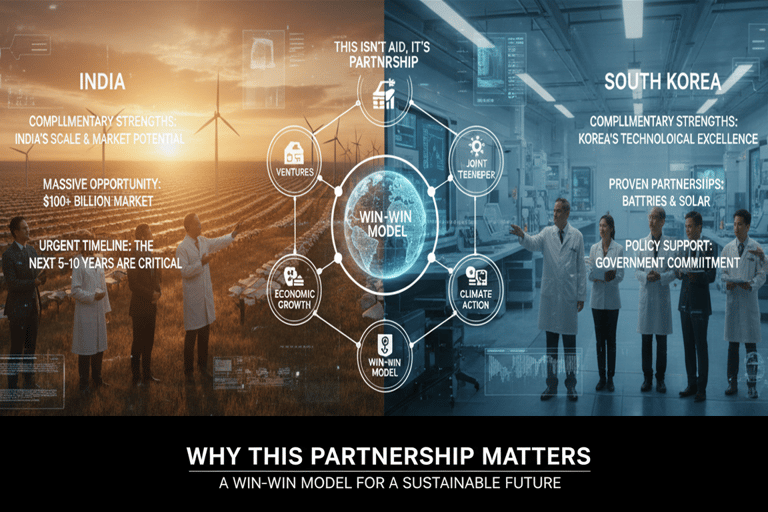

Conclusion: Building Bridges for a Sustainable Future
The climate crisis demands bold, collaborative solutions. No single nation can solve it alone. But when two dynamic economies—one offering unprecedented scale and growth, the other bringing world-class technology and innovation—come together with shared purpose, extraordinary things become possible.
The India-Korea partnership in green innovation isn't just about meeting climate targets or capturing market opportunities. It's about demonstrating a new model of international collaboration—one based on mutual respect, complementary strengths, and shared prosperity.


At Donghaeng-Manthan, we're committed to making this vision a reality. Through our platforms for collaboration, knowledge exchange, and partnership facilitation, we're helping build the bridges that will carry both nations—and the world—toward a sustainable future.
The question isn't whether India and Korea should collaborate on green innovation. The question is: how fast can we accelerate this partnership to meet the urgent challenges ahead?
Join us in building these bridges. The sustainable future both our nations—and our planet—need depends on it.
About
Donghaeng-Manthan
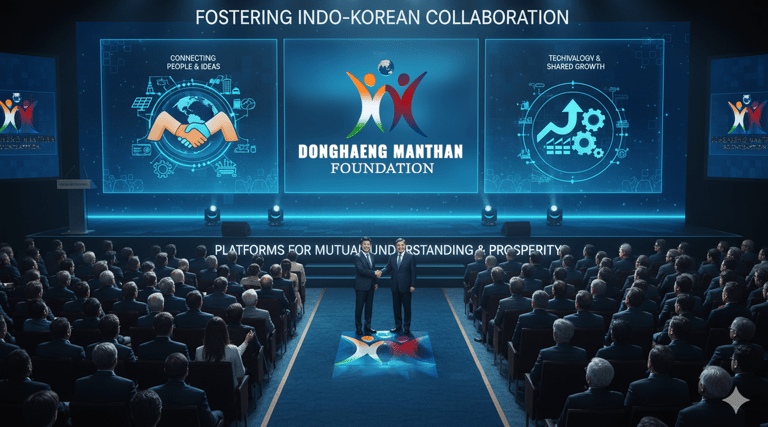

Donghaeng-Manthan is an Indo-Korean foundation dedicated to fostering collaboration between India and South Korea in technology and sustainable development. We create platforms that connect people, ideas, and industries—promoting innovation, mutual understanding, and shared growth between both nations.
Interested in partnering with us or learning more about India-Korea green innovation collaboration? Reach out to us at connect@donghaeng-manthan.org
Join us in sustainable innovation efforts.
Engage
Support
© Donghaeng-manthan 2025. All rights reserved.
